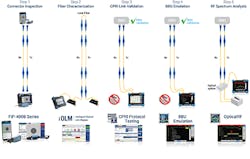Optimizing the RAN Revolution —
A major factor driving the development of 5G is the exponential growth in mobile bandwidth requirements fueled by the ever-increasing number of connected devices. With a peak data-rate objective 100x faster (10 Gbit/s vs. 100 Mbit/s) and number of connected devices per square km 1000x greater than 4G, the supporting infrastructure required for 5G must be ready to handle a massive increase in data traffic.
Since the objectives and expectations of 5G are dependent on big increases in bandwidth, fiber builds on both the fronthaul and backhaul are sure to continue to rise as mobile operators move from copper to fiber and migrate from traditional distributed radio access networks (D-RANs) to centralized radio access networks (C-RANs). Traditional mobile installations used copper to interconnect base station equipment to antennas at the top of cell towers or rooftops. But that legacy copper architecture does not scale well in terms of capacity and bandwidth requirements needed to support ever-increasing subscriber demands.
Moving from copper to fiber cabling offers mobile network operators (MNOs) many advantages in terms of reducing total cost of operation, achieving better area coverage, delivering higher bandwidth, as well as future-proofing networks in preparation for 5G. To deliver the promise of 5G, centralization of Baseband units will be a prerequisite. In the common D-RAN topology, the BBU and the remote radio head (RRH) are collocated, whereas in a C-RAN topology, the BBUs are placed up to 15 kilometers away from antenna sites.
The move from D-RAN to C-RAN delivers many advantages to MNOs but also includes its share of challenges. The fact that optical fiber is unfamiliar to many in the wireless industry adds a new level of complexity to the installation and construction of mobile infrastructures. Due to longer fiber spans, many more connections are required resulting in a potential increase in fiber-related issues including dirty/damaged connectors or bent fibers — all leading to optical link loss. To avoid those issues, the implementation of a highly-accurate fronthaul test solution is required.
MNOs must build a robust fiber-based mobile fronthaul foundation today to use as the building block for tomorrow’s 5G networks. This means accurate testing and validation of today’s D-RAN and C-RAN networks is crucial. Without the correct testing procedures and right test solution, field technicians could spend hours or even days troubleshooting many common fiber optic and RAN-network installation issues. This could translate into huge costs for mobile network operators.
C-RAN Deployment Challenges
Due to the RAN evolution, traditional copper-based mobile installations are being replaced by fiber-based mobile installations. With C-RAN installations, active transport equipment is required to reduce the fiber count between the centralized BBUs, placed many kilometers away, and the RRH located at the antenna site. Active transport equipment will use CWDM or DWDM technologies to transport all the CPRI links on a single fiber to and from the BBU hotel and the RRH. In active C-RAN networks, since active equipment is placed between the BBU and the RRH, the complexity of mobile installations increases making network architecture, installation, and testing processes more complicated.
The increased number of RF interference sources is becoming another troublesome issue for carriers. Network densification, resulting from a spike in the deployment of both small and macro cells, and an increase in frequency-band usage are together multiplying the sources of signal interference. Quickly identifying and fixing interference issues is critical to maintaining end-user quality of experience (QoE).
The technician workforce must also evolve to become more versatile. Technicians must become hybrid technicians — a form of super technician trained to deal with multiple technologies (e.g., fiber-optics, CPRI, RF, and Ethernet). Add in today’s accelerated deployment process, with the need to ensure quicker time to repair, technicians will be very busy learning to manage more technologies at a faster pace.
Increasingly stringent network performance requirements including the need to test for higher bandwidth, stricter latency targets, and traffic prioritization across multiple technologies, adds a few final line items to the list of challenges. These challenges are not predictions — they are present today.
A Tier-1 MNO in the US recently noted that 60% to 70% of their active C-RAN deployments experienced installation issues including improper transport equipment configuration, improper use of colored optics, and various fiber interconnection issues. With all these varied problems, "good enough" testing is no longer "good enough" anymore. Instead, a more complete and thorough process is required.
A 5-Step Approach
To overcome these challenges, installation and verification teams require optimized solutions that facilitate a best practice test and measurement approach to validating mobile fronthaul networks.
The best option for MNOs is to develop solutions and methods of procedure (MOPs) to minimize, or even eliminate, those installation challenges. A 5-step approach outlined here delivers a strong methodology for mobile fronthaul/C-RAN installation, construction, maintenance, and troubleshooting.
Step 1. Fiber connector inspection
Proper fiber connector inspection, the first critical step to deploying fiber networks, ensures good communication between the BBU and the RRH.
Since dirty or damaged connectors are the number one source of issues in any fiber-based network, careful inspection is imperative. An automated, easy-to-use fiber inspection probe with clear and accurate pass-fail results should be a technician’s go-to tool.
Step 2. Fiber characterization
Essential to ensuring a clean optical link between the BBU and the RRH, fiber characterization is critical — especially with the longer fiber spans associated with C-RAN architectures (spans up to 15 km).
With the proper OTDR tool, important issues such as optical loss, fiber macrobends, or even incorrect interconnections between the BBU hotel and the RRH at the antenna site, can be quickly flagged for repair while technician teams are still in place.
Step 3. CPRI link validation
Confirmation that the protocol link carrying digital RF information between the BBU and the RRH is operational can be done through a CPRI link validation test. Damaged fiber, SFP issues and incorrect port connections at the RRH are all examples of problems that can be flagged by thorough testing. Again, it is especially important to do this validation while technicians are still on site to quickly resolve issues.
Step 4. BBU emulation
This test validates that the RRH can begin transmitting and receiving RF data. It validates the CPRI communication link, examines the SFP inside the RRH ensuring the correct SFP is installed so that power levels can be read (both RX and TX), and performs RF-level testing, including VSWR measurement, implied passive intermodulation (PIM) and diversity imbalance testing.
Proper emulation can flag coax-cabling issues (between RRH and the antenna) including non-compliance with torquing specifications and bent cables that result in PIM interference issues.
Step 5. RF spectrum analysis over CPRI (or OBSAI)
Once a BBU is commissioned, an optical splitter can be placed between the BBU and the RRH that are located kilometers away from each other, allowing technicians to tap into the CPRI signal to extract digital RF information for spectrum analysis and establish a baseline for reference. This analysis can detect critical interference issues such as external RF interference, internal or external passive intermodulation (PIM) issues, and even hard-to-detect intermittent issues that degrade quality of service.
Strong Process = Stellar Results
To ensure accurate C-RAN cell site construction and maintenance as well as complete fronthaul and backhaul validation, MNOs should implement an efficient, yet thorough, 5-step approach for cell-site commissioning. Without the right test and measurement tools, field technicians could spend hours or even days troubleshooting many of the common fiber optic and RF issues encountered during installation and turn up.
The approach outlined above (and shown in Figure 1) optimizes field performance with simple, automated test tools and applications that require less training, designed for cell-site technicians, at any skill level, to master. EXFO’s FTB-700G V2 Series is used throughout the 5-step approach and combines Ethernet service validation, connector endface inspection, fiber characterization testing, CPRI link validation, BBU emulation, and RF spectrum analysis over CPRI/OBSAI, into a single test solution. Following these 5 steps ensures that the fiber-based fronthaul and C-RAN installations built today are solid — ready for future 5G networks.
Figure 1. The 5-step approach to validating mobile fronthaul networks.
Save
Save
Save
Save






